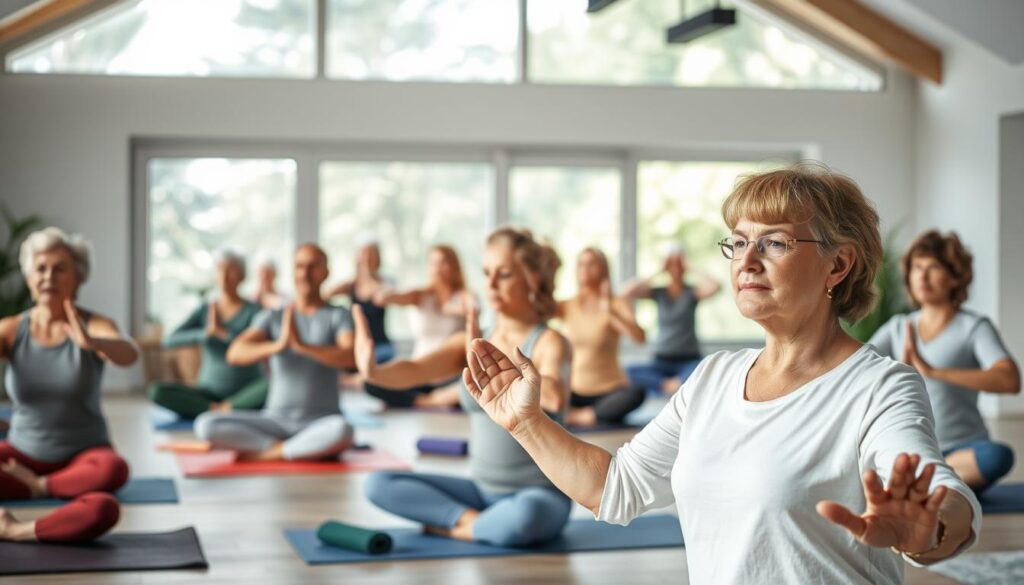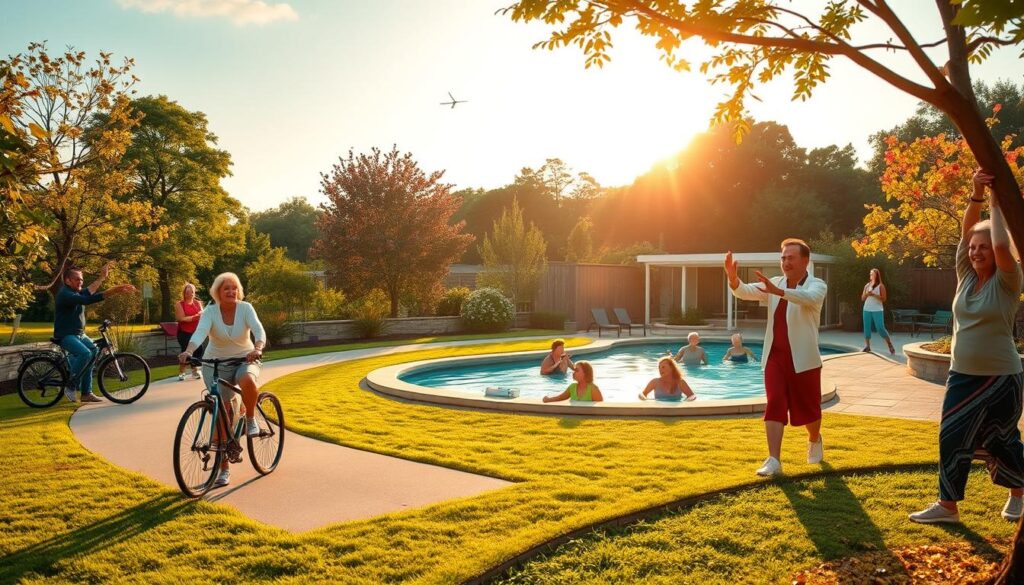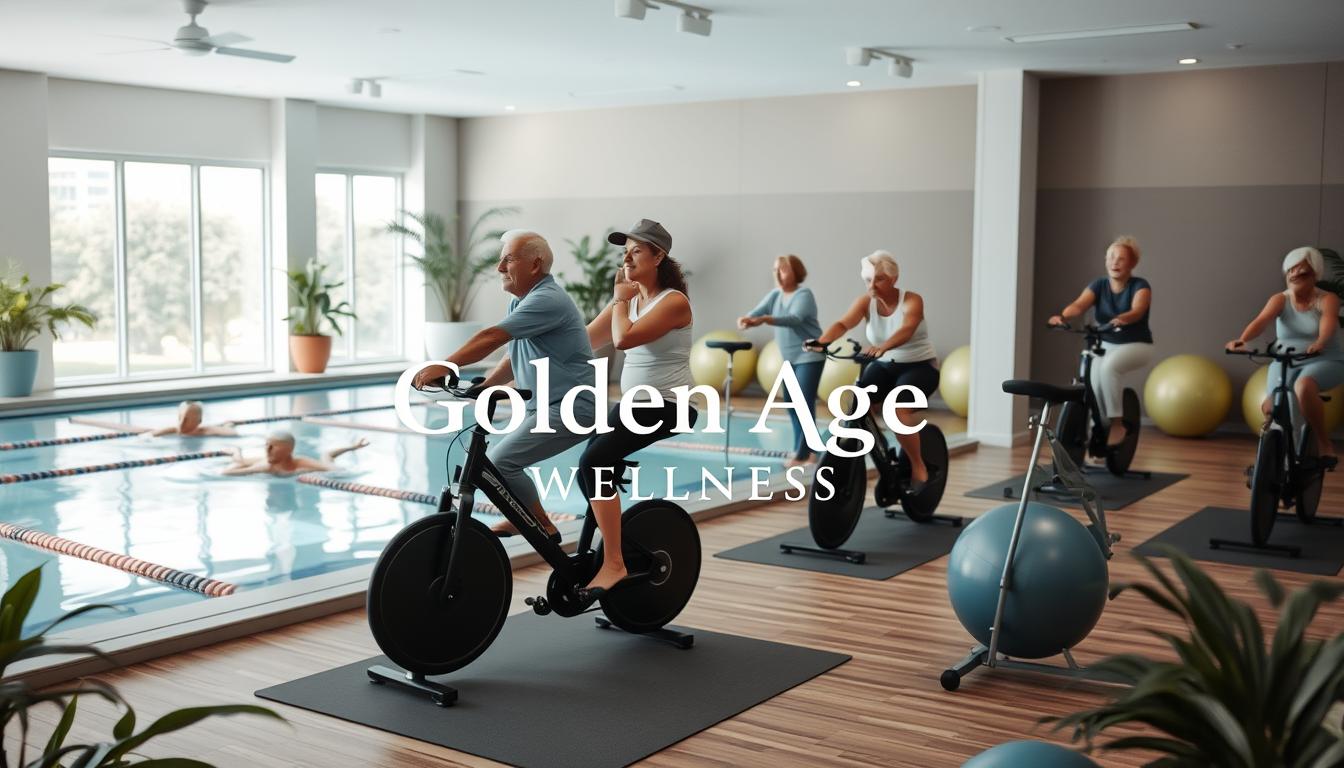Do you have arthritis and find it hard to exercise? You're not alone! The right cardio can help a lot without making your symptoms worse1. This guide about arthris-friendly cardio will show you many safe and fun ways to stay active and manage your arthritis.
Key Takeaways
- Low-impact, joint-friendly cardio can alleviate pain and improve flexibility without worsening arthritis symptoms.
- Water exercises like walking and aerobics significantly reduce joint stress compared to land-based activities.
- Strengthening exercises, yoga, and Tai Chi can improve overall fitness, balance, and pain management.
- Modifying your workout routine and gradually increasing intensity are crucial for staying active with arthritis.
- Regular exercise, even at a moderate level, can ease pain, enhance mobility, and support overall health.
Introduction to Arthritis-Friendly Cardio
Low-impact cardio exercises offer many benefits for individuals with arthritis2. They strengthen muscles, improve joint flexibility, and boost endurance without stressing joints too much2. It's key to think about your specific arthritis type and severity when picking exercises.
Benefits of Low-Impact Exercise for Arthritis
Low-impact exercises are great for arthritis because they help manage symptoms without worsening joint pain or swelling2. Studies show that exercise is the best non-drug way to reduce pain and improve movement in osteoarthritis patients3. A mix of flexibility, strengthening, and endurance exercises is especially good for people with arthritis2.
Considerations for Exercising with Arthritis
When you have arthritis, it's vital to work with a healthcare provider or physical therapist to make sure your cardio fits your needs2. For osteoarthritis, aim for 150 minutes of moderate or 75 minutes of vigorous exercise a week3. Start slowly and build up to avoid making symptoms worse2.
Aquatic exercises are great for those with severe arthritis or low fitness, as they put less pressure on joints23. Wearing supportive shoes and inserts can also help reduce impact on hips, knees, and feet during workouts2.
"A balanced program of flexibility, strengthening, and endurance exercises is beneficial for all people, especially those with arthritis."
By adding low-impact cardio to your routine and getting help from healthcare pros, you can manage your symptoms and live better23.
Water Exercises for Arthritis Relief
If you have arthritis, water exercises can change your life. The water makes moving easier on your joints. This means you can do water walking, water aerobics, and swimming without pain. These activities boost your mobility, muscle strength, and heart health4.
Arthritis-friendly cardio water exercises can also cut down on joint pain and swelling4. Always talk to your doctor before starting any water exercise program. This makes sure it's right for your condition4.
Water Walking
Water walking is easy on your joints and gets your heart rate up. Walking in the water reduces stress on your joints. Try different movements like walking forward, stepping sideways, and even jogging4.
Water Aerobics
Water aerobics is great for arthritis. The water's resistance strengthens your muscles gently. You can do deep steps, arm movements, leg kicks, and cycling motions4.
Studies show women with rheumatoid arthritis see big improvements. They do water exercises three times a week for sixteen weeks. They feel better in pain and function than those doing land-based exercises5.
Swimming
Swimming is perfect for arthritis because it's low-impact. The water's weightlessness lets you move freely. Whether you like slow laps or fast swimming, it helps with arthritis symptoms4.
A Cochrane Review found aquatic exercise helps with knee or hip osteoarthritis. It improves pain and function5.
Start slow and work with a qualified instructor for water exercises. This ensures you're doing it right and safely. Arthritis-friendly cardio helps you get the most benefits without making your symptoms worse4.
| Water Exercise | Benefits | Considerations |
|---|---|---|
| Water Walking |
|
|
| Water Aerobics |
|
|
| Swimming |
|
|
Water exercises can be a game-changer for arthritis. They offer a low-impact way to stay active and build strength. By adding these activities to your routine, you can manage your arthritis symptoms better. Enjoy a more active and pain-free life45.
"Water exercise removes the impact stress of ground reaction force, making it ideal for those with inflamed and painful joints during weight-bearing exercises."5
Low-Impact Land-Based Activities
There are many land-based activities that are good for people with arthritis. Walking and hiking on smooth paths can strengthen muscles and improve fitness without too much strain6. Walking puts a lot of pressure on knees, but it's still a good choice for those with arthritis.
Cycling is another low-impact option that's good for the heart and joints6. Make sure to wear the right shoes and adjust the bike to fit you. Always check with a doctor before starting any new exercise6.
Studies show that exercise therapy helps people with osteoarthritis in the hips or knees7. Strength training can also improve their condition7. Activities like walking, hiking, and cycling help people with arthritis stay active and manage their condition well.
Mind-Body Exercises for Arthritis
If you have arthritis, adding mind-body exercises to your routine can really help. Practices like yoga and tai chi are great. They focus on slow movements, balance, and deep breathing. This can ease joint pain, boost flexibility, and improve overall health8.
Yoga for Arthritis: Arthritis-friendly Cardio
Yoga is a smart choice for arthritis sufferers. It involves gentle poses and sequences that strengthen muscles and improve joint movement. It also helps reduce stress, which can lessen arthritis symptoms9.
When you start yoga, you can find an instructor who can adjust poses for your needs. This ensures you can do the exercises safely and effectively.
Tai Chi for Arthritis
Tai chi, a traditional Chinese martial art, is also beneficial for arthritis. It involves smooth movements that enhance balance, flexibility, and muscle strength. These are key for managing arthritis810.
The meditative part of tai chi also helps lower stress. It brings a sense of calm and well-being.
Adding yoga and tai chi to your routine for arthritis is a good move. Start slow, listen to your body, and get guidance from a qualified instructor. With time and effort, these exercises can be powerful in managing your arthritis and keeping you active.

Strength Training for Arthritic Joints
Adding strength training to your routine is key for arthritic joints. It helps build muscle strength to ease pressure on joints and boost stability11. Start with light weights and focus on proper form to avoid straining your joints. Working with a physical therapist or certified trainer ensures your program meets your needs.
Regular strength training brings many benefits for those with arthritis. It can reduce pain, fatigue, and inflammation11. It's as effective as diabetes drugs in lowering blood sugar levels11. Yet, many with arthritis move less and have weaker muscles11.
When starting strength training, be patient. It may take six to eight weeks to see fitness gains11. Experts suggest making small increases in exercise intensity or duration, like a 10% or 20% boost11. Those who exercise have a lower risk of stiff and painful joints11.
A good exercise program should include cardio, strength training, and mobility and balance work for arthritis patients11. Strength training is key for building muscles to support and protect joints11.
"A tailored program with three types of exercises (range-of-motion, strengthening, and endurance) can relieve arthritis symptoms."12
Designing a strength training routine for arthritis should focus on exercises for the affected joints. Isometrics and isotonic exercises strengthen muscles without harming joints12. Building muscle strength keeps weak joints stable and comfortable, protecting them from further damage12.
| Exercise Type | Benefits for Arthritis |
|---|---|
| Range-of-Motion Exercises | Help maintain joint function and increase joint mobility12. |
| Strengthening Exercises | Build muscle strength to support and protect joints12. |
| Endurance Exercises | Improve overall physical conditioning and control weight12. |
By adding a balanced strength training routine to your arthritis management plan, you can actively manage your condition. This improves your overall quality of life.
Arthritis-Friendly Cardio: Low-Impact Fitness Options
Finding the right cardio exercises is key for managing arthritis13. Physical activity helps with less pain, more energy, better sleep, and daily function13. The American College of Rheumatology says exercise is a main treatment for hip and knee osteoarthritis.
Water-based exercises are great for those with arthritis14. Lap swimming and water aerobics offer resistance without joint pressure. Regular walking also helps with arthritis symptoms and joint pain14.
| Exercise Type | Benefits for Arthritis |
|---|---|
| Water Exercises | Provide natural resistance and eliminate pressure on joints |
| Walking | Benefit arthritis symptoms and reduce joint pain |
| Strength Training | Strengthen muscles around joints, reducing joint pain |
| Yoga | Improve balance, flexibility, and body awareness |
14 Resistance bands, free weights, and machines strengthen muscles, easing joint pain14. Yoga also boosts balance, flexibility, and body awareness in those with arthritis.
Always talk to a healthcare provider before starting a new exercise routine14. This ensures you avoid exercises that could harm your joints.

15 Dr. Linda Li and Dr. Jasmin Ma, along with the Arthritis Patient Advisory Board, launched a 30-day exercise challenge15. It suggests strength training 2-3 times a week and endurance activities 4-5 times a week15. Aim for 5,000 to 6,000 steps on rest days and 6,000 to 10,000 steps daily15. Rest days are important for recovery, with one to two days recommended to reduce body stress.
Exploring these options can help you find exercises that ease symptoms, boost fitness, and improve your life quality.
Joint-Friendly Aerobic Routines
Looking for a workout that's tough but easy on your joints? Try elliptical training or low-impact dance workouts. Elliptical machines offer a smooth motion that's easy on your lower body, perfect for those with arthritis16. Low-impact dance, like Zumba, is fun and keeps your heart rate up without hurting your joints16.
Elliptical Training
Elliptical training is great for your heart and muscles without stressing your joints. Its smooth motion is easy on your knees, hips, and ankles, making it ideal for people with arthritis or joint issues16. You can boost your heart health and protect your joints by slowly increasing the workout's intensity and length16.
Low-Impact Dance Workouts
Low-impact dance workouts, such as Zumba, are lively and fun. They're a great way to get your heart rate up without hurting your joints16. These dances are gentle, letting you move freely and enjoy the music while being kind to your joints16. As you get better, you can make the routines more challenging.
When starting these exercises, start slow and get more intense as you get fitter16. Always talk to a doctor before starting any new exercise, especially if you have joint problems17.
"Regular physical activity can help manage arthritis symptoms and improve overall health and well-being."
| Exercise | Benefits | Considerations |
|---|---|---|
| Elliptical Training |
|
|
| Low-Impact Dance Workouts |
|
|
Choosing joint-friendly exercises like elliptical training and low-impact dance can help you stay active and healthy, even with arthritis or joint issues16. Work with your doctor and slowly increase the workout's intensity to enjoy cardio benefits while keeping your joints safe17.
Anti-Inflammatory Cardio Workouts
Adding anti-inflammatory cardio to your workout can change your life if you have arthritis. With arthritis-friendly Cardio, these low-impact exercises boost your fitness and help control your condition. They reduce joint inflammation and lower the chance of flare-ups18.
Swimming, cycling, and gentle yoga are great for those with arthritis18. Swimming is especially good because it's easy on your joints. It improves flexibility and fitness without harming your joints18. Aquatic exercises also help with flexibility, range of motion, and strength19.
Stationary bike riding is another good choice. It's good for your heart and eases stiffness without too much strain19. Yoga and Tai Chi also help people with RA. They improve flexibility, range of motion, and overall health19.
Always talk to your doctor before starting a new exercise plan, especially if you're having a flare-up. They can create a workout plan that fits your needs and limits18.

By adding these anti-inflammatory cardio workouts to your routine, you can manage your arthritis better. Regular exercise not only cuts down on inflammation but also strengthens the muscles around your joints. This leads to better support and less pain.18
Tips for Safe and Effective Arthritis Exercise
Managing arthritis means focusing on safety and flexibility in your workouts. A good warm-up and cool-down can get your body ready and lower injury risks20. It's also important to listen to your body and adjust exercises when you're having a flare-up. This way, your workouts stay effective and easy to handle.
Warm-Up and Cool-Down Routines: Arthritis-friendly Cardio
Warming up and cooling down are key for people with arthritis. Begin with easy movements to boost blood flow and stretch your joints gently. Activities like walking, jogging, or water walking or cycling21 are great. Spending 5-10 minutes on these routines can prevent injuries and make your workouts more comfortable.
Modifying Exercises for Arthritis Flare-Ups
When you're in a flare-up, it's time to adjust your workout. Try low-impact activities like swimming or water aerobics to ease joint stress21. You might also need to change the intensity, how long you do it, or how much you move. Paying attention to your body and making changes helps you stay active while managing your arthritis.
"Physical activity can improve physical function by about 40% and may reduce healthcare costs."20
By following these tips, you can enjoy the benefits of being active while keeping your joints healthy. Remember, being consistent and flexible is crucial for a workout plan that suits you.
Conclusion for Arthritis-friendly Cardio
Engaging in arthritis-friendly cardio exercises can greatly help manage your symptoms and improve your life22. You can choose from low-impact, joint-friendly activities like water-based exercises, land-based activities, and mind-body practices23. Start slow, listen to your body, and work with your healthcare team to make sure your workouts are safe and effective22.
With the right approach, you can manage your arthritis and live an active, fulfilling life.
The conclusion of this article highlights the importance of finding the right exercise routine for your condition23. Low-impact, joint-friendly activities can improve your physical and mental health while avoiding the risks of high-intensity exercises22. With your healthcare team's guidance and a commitment to your health, you can manage your arthritis better and live a more active life.
Remember, finding the right cardio exercises for your arthritis may take time and effort23. But with patience, perseverance, and the right approach, you can find exercises that meet your unique needs23. Stay informed, listen to your body, and embrace a holistic approach to your health. This way, you can take control of your arthritis and thrive despite the challenges it presents.
FAQ for Arthritis-friendly Cardio
What are the benefits of engaging in low-impact cardio exercises for individuals with arthritis?
What are some examples of water-based exercises that are suitable for individuals with arthritis?
What are some low-impact land-based activities that can be arthritis-friendly?
How can mind-body exercises, such as yoga and tai chi, be beneficial for individuals with arthritis?
How can strength training support and protect arthritic joints?
What are some joint-friendly aerobic exercise options for individuals with arthritis?
How can certain types of cardio exercise have anti-inflammatory effects for individuals with arthritis?
What are some tips for ensuring safe and effective arthritis-friendly cardio workouts?
Source Links for Arthritis-friendly Cardio
- No title found - https://www.arthritis.org/health-wellness/healthy-living/physical-activity/other-activities/14-ways-to-work-out-with-arthritis
- Patient education: Arthritis and exercise (Beyond the Basics) - https://www.uptodate.com/contents/arthritis-and-exercise-beyond-the-basics/print
- No title found - https://www.arthritis.org/health-wellness/healthy-living/physical-activity/getting-started/benefits-of-exercise-for-osteoarthritis
- 13 Best Water Exercises for Alleviating Arthritis - https://www.orthobethesda.com/blog/water-exercises-for-alleviating-arthritis/
- Water Exercises to Ease Arthritis Pain: 8 Moves You Will Love Doing - https://creakyjoints.org/diet-exercise/water-exercises-for-arthritis/
- 5 Low-Impact Activities to Avoid Joint Pain - https://northcentralsurgical.com/5-low-impact-activities-to-avoid-joint-pain/
- Exercise for people with hip or knee osteoarthritis: a comparison of land-based and aquatic interventions - https://www.ncbi.nlm.nih.gov/pmc/articles/PMC3781862/
- 16 Gentle Exercises for People With Arthritis - https://www.health.com/condition/rheumatoid-arthritis/16-gentle-exercises-for-people-with-arthritis
- Exercises for Arthritis: 11 Exercises with Instructions - https://www.healthline.com/health/exercises-for-arthritis
- 10 exercises for arthritis of the knee - https://www.medicalnewstoday.com/articles/311138
- No title found - https://www.arthritis.org/health-wellness/healthy-living/physical-activity/getting-started/exercise-and-strength-training-with-arthritis
- Exercise to Treat Arthritis - https://www.webmd.com/arthritis/exercise-treat-arthritis
- Exercise & Arthritis - https://rheumatology.org/exercise-and-arthritis
- Low-Impact Exercises For Joint Health – Orthopaedic Associates of Duluth - https://oaduluth.com/blog/exercise-and-arthritis-low-impact-exercises-for-joint-health
- Arthritis Exercise Challenge: 30-Day Home Workout Program for Arthritis - https://www.arthritisresearch.ca/30-day-exercise-challenge-for-arthritis/
- Six exercises that are easy on your joints - https://www.honorhealth.com/healthy-living/6-exercises-are-easy-your-joints
- About Physical Activity and Arthritis - https://www.cdc.gov/arthritis/prevention/index.html
- Joint-Friendly Fitness Routines for RA - https://www.webmd.com/rheumatoid-arthritis/ss/slideshow-ra-exercises
- No title found - https://www.arthritis.org/health-wellness/healthy-living/physical-activity/other-activities/best-exercises-for-rheumatoid-arthritis
- Stay Active with Osteoarthritis - Osteoarthritis Action Alliance - https://oaaction.unc.edu/active-living/
- You Can — and Should — Exercise with Arthritis. Here’s How to Make It Easier - https://creakyjoints.org/living-with-arthritis/exercise/exercising-with-arthritis-tips/
- Benefits of Exercise in Rheumatoid Arthritis - https://www.ncbi.nlm.nih.gov/pmc/articles/PMC3042669/
- Peer Reviewed: The People with Arthritis Can Exercise (PACE) Program: A Qualitative Evaluation of Participant Satisfaction - https://www.ncbi.nlm.nih.gov/pmc/articles/PMC1364520/

[…] therapy reduces weight bearing and joint compression, offering much-needed relief2.Buoyancy for Low-Impact WorkoutsWater's buoyancy makes movement easier and less painful for those with arthritis1. People can do […]
[…] Buoyancy for Low-Impact Workouts […]
[…] managing your arthritis, consider adding tai chi to your lifestyle. This gentle, low-impact activity can bring many physical and mental benefits. It empowers you to manage your arthritis and live a […]
[…] Non-impact cardio, like riding a stationary bike or walking, benefits arthritis patients2. Adults, including those with arthritis, should aim for 150 minutes of moderate activity weekly3. Low-impact activities like biking and swimming reduce joint stress and boost heart health4. Working with a physical or occupational therapist to create a personalized exercise plan is crucial. Avoid overdoing activities like bending, kneeling, and lifting, as they can worsen pain2. Using aids like canes, crutches, or walkers can also help ease pressure on arthritic knees or hips2. It's vital to listen to your body and gradually increase exercise intensity and duration. Overworking muscles can make joint pain worse for arthritis patients4. By adopting a balanced approach to movement and exercise, you can manage your arthritis symptoms and enhance your life quality. […]
[…] cardio exercises to your routine is key for managing arthritis. Arthritis-friendly cardio activities like walking, […]